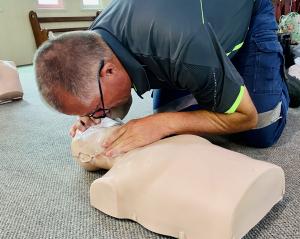Kiss or no kiss? The difference between giving CPR with and without mouth-to-mouth explained
CPR is an essential lifesaving technique, but which one is best? Experts explain the two main CPR techniques and which to use in certain circumstances.
BRISBANE, QUEENSLAND, AUSTRALIA, February 22, 2023 /EINPresswire.com/ -- Cardiac arrest is a leading cause of death in Australia and the world over for both young and old and survival rates vary greatly depending on the promptness and quality of the response.
Cardiopulmonary resuscitation (CPR) is an essential lifesaving technique that can help improve survival rates for people experiencing cardiac arrest. However, there are two different techniques promoted for performing CPR: chest compressions only and CPR with resuscitation breaths (mouth-to-mouth) and compressions.
So which technique is best — kissing or no-kissing?
Understanding the differences between these techniques can help individuals determine which method to use in an emergency situation.
CPR with resuscitation breaths and compressions is the traditional method of CPR, involving the use of rescue breaths and chest compressions. The technique recommended by the Australian Resuscitation Council (ARC) and taught in accredited CPR Courses, involves delivering two rescue breaths after every 30 chest compressions to help deliver oxygen to the lungs and keep the blood flowing.
Brisbane CPR course provider My First Aid Course, says this method is most effective in providing both air and blood circulation to the body and can be especially helpful for individuals who may have drowned or been exposed to smoke or other toxins.
However for many people, the idea of giving resuscitation breaths to a stranger during CPR can be uncomfortable or even intimidating. Although the risk of transmitting a disease during mouth-to-mouth resuscitation is generally low, it is still a valid concern for many individuals, and the ARC recommend using barrier mask for personal protection, especially if the casualty is unknown to the rescuer.
Is there an easier, less intimidating CPR techique that may be just as effective?
Enter chest compressions only, or hands only CPR.
Another technique promoted more prominently in the media of recent years, involves using only chest compressions to help circulate blood through the body. This technique has been found to be as effective as traditional CPR in many cases, and is often recommended in cases where rescuers are either unable or unwilling to deliver rescue breaths.
My First Aid Course says chest compressions only CPR can be easier to learn and perform, as it does not require the use of rescue breaths, or the need for a barrier mask, so it can help reduce the risk of disease transmission and can reduce the time it takes bystanders to start CPR.
It's important to note that both techniques can be effective and can help save lives in an emergency situation. The decision to use one technique over the other may depend on a number of factors, including the availability of trained responders, the condition of the victim, and the situation in which the emergency occurs.
Learning CPR is an important skill that can help individuals become more confident and prepared to respond in an emergency situation. Attending a CPR training course like those provided by My First Aid Course in Brisbane, can help individuals learn the proper techniques for performing both chest compressions only CPR and CPR with resuscitation breaths and compressions.
In addition to learning the technical aspects of CPR, these courses can also help individuals develop the confidence and presence of mind necessary to act quickly and decisively in a life-threatening situation.
In conclusion, knowing the differences between chest compressions only CPR and CPR with resuscitation breaths and compressions can be helpful in determining which technique to use in an emergency situation. Both techniques are effective and can help save lives, and learning CPR through a training course can provide individuals with the knowledge and skills necessary to respond confidently and effectively in an emergency.
Brisbane residents interested in accredited CPR training course can find more information and book course on the My First Aid Course website.
M. Thompson
My First Aid Course Pty Ltd
email us here
Visit us on social media:
Facebook
LinkedIn
Legal Disclaimer:
EIN Presswire provides this news content "as is" without warranty of any kind. We do not accept any responsibility or liability for the accuracy, content, images, videos, licenses, completeness, legality, or reliability of the information contained in this article. If you have any complaints or copyright issues related to this article, kindly contact the author above.

